Updated: August 18, 2022
Written by Adam Graham
Cristina has more than 4 years of experience in the remodeling and home design sector. She joined Fixr.com in 2017 and has since been working constantly with industry experts to bring the most accurate and reliable information regarding news, trends, and advice to homeowners and other industry pros. Her work has appeared in major industry publications, like Forbes, Realtor.com and the official publication of the National Kitchen & Bathroom Association.
Learn moreReviewed by Cristina Miguelez
An arbor is an archway or vertical structure on walkways, paths, gardens, or entrances. Most homeowners purchase an arbor to enhance the beauty of their yard. While these structures make a great accent piece, they have many advantages for your home and yard. Arbors provide a shaded space great for outdoor gatherings, act as a shield from harsh weather, support climbing plants, create an entranceway, and increase your home’s value.
The national average cost for installing an arbor is between $2,500 and $4,500, with most people paying around $3,500 for a custom 8’ x 8’ wooden arbor with a grape style and bench. This project’s low cost is $750 for a professionally installed 6’ x 4’ prefabricated aluminum arbor with a simple arch. The high cost is $8,500 to have a custom-built 12’ x 12’ teak wooden arbor with a bench and intricate decorations.
Arbor Installation Cost
| Arbor Cost | |
| National average cost | $3,500 |
| Average range | $2,500-$4,500 |
| Low-end | $750 |
| High-end | $8,500 |
Cost to Build an Arbor by Construction Method
There are two options for constructing an arbor. A prefabricated arbor is brought to your home to assemble on-site, or you can choose a custom-made option. Prefabricated arbors are easier to find and less expensive. A custom arbor is one made entirely to your requirements. The material, design, and size are up to the homeowner. Below are the costs for prefab and custom arbors in an 8’ x 8’ size, including materials and installation.

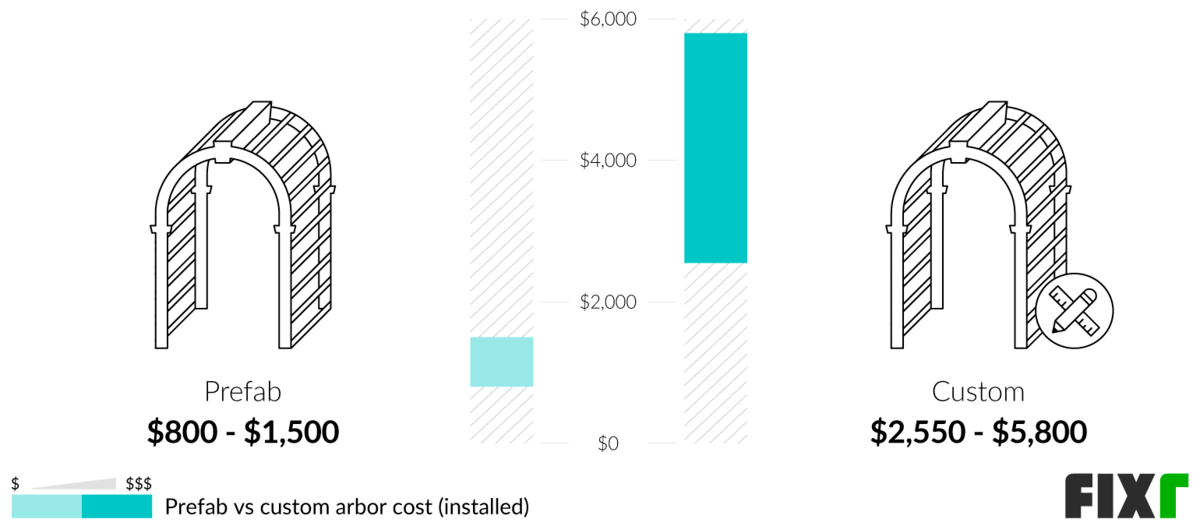
| Construction Method | Cost (Installed) |
| Prefab | $800 - $1,500 |
| Custom | $2,550 - $5,800 |
Prefab Arbor
Prefabricated arbors range from $800 to $1,500, including installation and material costs. These arbors can be found in many materials, including some not available as custom options because some materials, such as wood and brick, are manipulated more easily. Some options include metal, composite, alumawood, vinyl, and fiberglass. When selecting a prefab arbor, the materials are ready and assembled in your yard. In addition to arbor materials only available in prefab, you can also choose from a wide selection of wood options. These are easy to install, making them great for many homeowners.
A Custom Arbor
Costs for a custom arbor range from $2,550 to $5,800, with installation and materials. When selecting a custom model, a professional shapes, cuts, and assembles the materials at your home. This differs from prefab, where the items are drilled, cut, and then need to be put together on your property. These arbors are more expensive, but that is not always the best option. If you need something more straightforward, custom costs more for little benefit. Custom arbors are typically created using wood or brick and make a good choice if you want a specific material, size, or shape.
Attached vs Freestanding Arbor Cost
Many arbors are available. However, there are only two fundamental types: attached and freestanding. While both are similar in the materials, installation process, and purpose, they differ in design. The type should depend on the location and surroundings. Freestanding and attached arbors are compared below and illustrated in the chart with their respective costs. This is based on an installed 8’ x 8’ arbor.

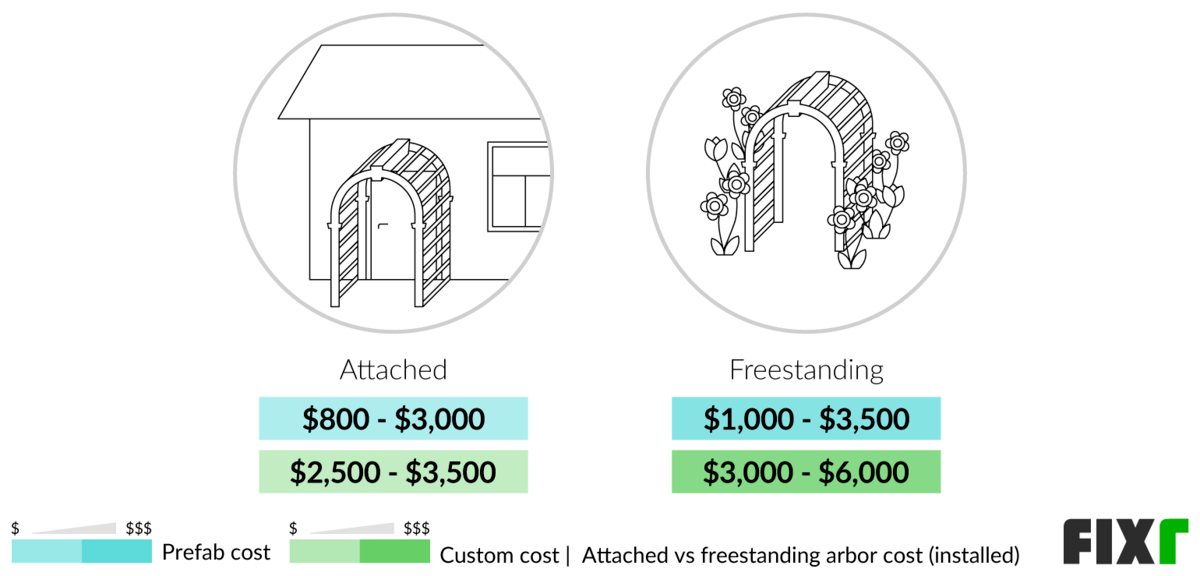
| Location | Prefab Cost | Custom Cost |
| Attached | $800 - $3,000 | $2,500 - $3,500 |
| Freestanding | $1,000 - $3,500 | $3,000 - $6,000 |
An Attached Arbor
The average cost for an attached prefabricated arbor is $800 to $3,000, including labor and materials, while a custom model ranges from $2,500 to $3,500. An attached arbor is defined as having one side attached to a wall or structure. The wall or structure supports the arbor and is mounted using a beam or anchor. Attached arbors require fewer legs than freestanding and are less expensive. You may need a special permit for an attached style because it may impact your taxes, depending on your municipality. This style should be installed by a professional to protect the home’s structural integrity. Attached arbors can be used on patios, decks, and entryways if a solid structure is nearby.
Freestanding Arbor
The average cost for a freestanding arbor is $1,000 to $3,500 when prefabricated or $3,000 to $6,000 for custom, including labor and materials. A freestanding arbor stands alone without attaching to another structure. They are independent of anchored surfaces and secured using stakes or posts mounted to concrete footings. Freestanding styles have no limitations on height, size, or orientation. A detriment of this style is the challenge of obtaining a permit for a freestanding structure because it can block your neighbors’ views. Expect to pay slightly more for freestanding styles because they have higher material costs. They require 4 posts to stand compared to those attached to a house. Entry arbors tend to be in yards or gardens, used for weddings, or may be entry arbors to designate spaces.
Cost of an Arbor by Size
Arbors should be tall enough for people to walk under comfortably and a good height to maintain vines or plants. The smallest arbors average 6’, while the average height is between 8’ and 10’. Some arched, gabled, or half-moon styles may be taller than others, such as grape. Expect to pay more for a 10’ arbor than a 6’ one. For example, building a 6’ arbor with a width of 4’ may cost $550 to $5,250, depending on if it is custom or prefab. A 12’ tall arbor with a 12’ width may cost between $1,800 and $7,500. In addition to the height, the width also influences the size. Some widths are better for specific locations than others. The chart below illustrates the most common arbor sizes and their respective costs, including installation.


| Size | Prefab Cost (Installed) | Custom Cost (Installed) |
| 6’ x 4’ | $550 - $1,050 | $2,050 - $5,250 |
| 6’ x 8’ | $650 - $1,250 | $2,300 - $5,500 |
| 6’ x 12’ | $700 - $1,350 | $2,400 - $5,600 |
| 8’ x 8’ | $800 - $1,500 | $2,550 - $5,800 |
| 8’ x 12’ | $900 - $1,600 | $2,650 - $5,850 |
| 10’ x 12’ | $1,050 - $1,750 | $2,800 - $6,000 |
| 12’ x 12’ | $1,800 - $2,750 | $3,800 - $7,500 |
Build a Small Arbor
A typical small arbor ranges from $550 to $1,250 for a prefabricated option or $2,050 to $5,500 for custom models. Many homeowners choose a small arbor for a yard because they want to add a design and aesthetic. Small arbors are 6’ x 4’ or 6’ x 8’, depending on your preference. These can be used in any location, making them a versatile option. They work on decks and patios, near pools, or as a way to showcase a garden.
Cost to Build an Arbor by Material
The cost of an arbor is influenced by the material, size, and design features. In addition, the cost between prefabricated and custom arbors also differs. There are several common materials for arbors, including vinyl, composite, wood, alumawood, fiberglass, brick, and metal. These materials differ in their pros, cons, lifespan, and cost and are known for appearance, structural integrity, and withstanding harsh weather. Expect to pay more for a brick or fiberglass arbor than a metal or wood arbor. Some arbors are not available in custom models because professionals tend to work with wood and brick as more details and intricacies can be added. The table below lists the most popular arbor materials available and their cost for a medium-sized installation of about 6’ x 12’ or 8’ x 8’.


| Material | Prefab Cost (Materials Only) | Custom Cost (Materials Only) |
| Wood | $100 - $600 | $500 - $1,000 |
| Metal | $100 - $850 | N/A |
| Composite | $500 - $700 | N/A |
| Alumawood | $500 - $750 | N/A |
| Vinyl | $500 - $800 | N/A |
| Fiberglass | $500 - $1,000 | N/A |
| Brick | N/A | $750 - $1,250 |
Wood Arbor
Expect to pay between $100 and $600 for a prefab wood arbor and $500 to $1,000 for a custom model, not including installation. For example, the construction cost of a timber-framed arbor is $800 to $1,000 for materials, while the cost for teak arbor materials is $900 to $1,000 for a medium-sized arbor. Other commonly used woods include cedar, bamboo, pine, oak, and redwood. While project prices are the best way to determine how much an arbor costs, some choose other methods.


| Material | Prefab Cost (Materials Only) | Custom Cost (Materials Only) |
| Cedar | $100 - $200 | $500 - $600 |
| Bamboo | $100 - $250 | N/A |
| Pine | $200 - $300 | $750 - $850 |
| Oak | $300 - $400 | $750 - $850 |
| Redwood | $400 - $500 | $800 - $900 |
| Timber | $400 - $600 | $800 - $1,000 |
| Teak | N/A | $900 - $1,000 |
Average Cost of a Metal Arbor
Expect to pay between $100 and $850 for a prefabricated metal arbor, not including installation. This varies by material. For example, a steel arch arbor costs $100 to $500, while a wrought iron arbor costs $100 to $850. A metal arbor is best when searching for an extremely durable arbor with unique styles. Unlike wood and other materials, you never have to worry about rotting, cracking, or infestations with metal. Their strength is unmatched. Metal arbors stand up to strong storms and winds and are great for growing plants. You can add extra eye appeal by painting your metal arbor to match your outdoor decor.

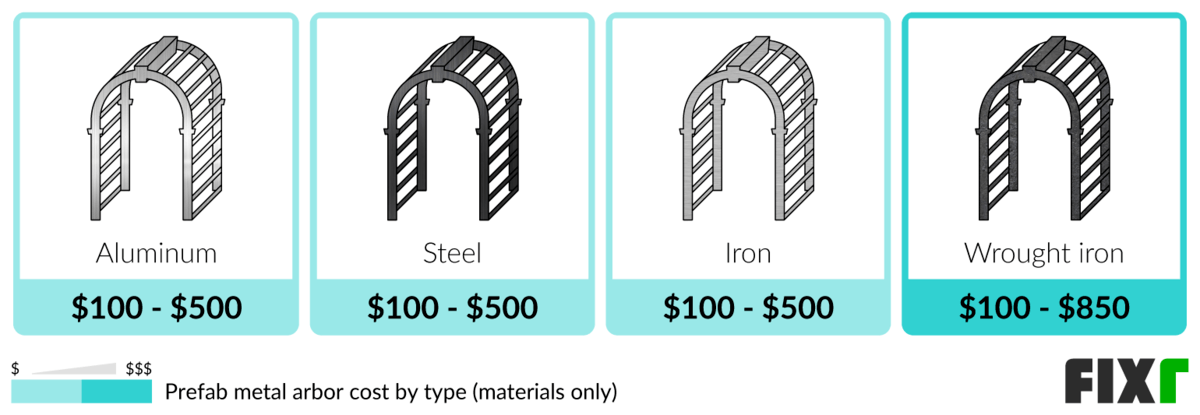
| Material | Prefab Cost (Materials Only) |
| Aluminum | $100 - $500 |
| Steel | $100 - $500 |
| Iron | $100 - $500 |
| Wrought Iron | $100 - $850 |
Composite Arbor
Expect to pay between $500 and $700 for a prefabricated composite arbor, not including installation. Composite arbors are extremely versatile that combine a wood appearance and composite durability. They are suitable for extreme climates and retain their visual appearance and finish for decades. The composite material is less likely to rot and does not need to be painted or stained. Unlike wood and some metal types, you do not need to spend extra on maintenance. Composite arbors last for at least 25 years.
Alumawood Arbor
For an alumawood arbor, materials without installation range from $500 to $750 for a prefabricated option. Alumawood is a material composed of aluminum embossed and shaped to look like wood. Unlike wood, alumawood does not rot because it is not made of organic materials. This means alumawood requires less maintenance and lasts longer before needing replacement. Homeowners can enjoy the look of wood without the extra time and cost.
Vinyl Arbor
Expect to pay between $500 and $800 for a vinyl (plastic) prefabricated arbor without installation. A vinyl arbor can be the best arbor material for style and practicality. Vinyl arbors are great for spaces prone to extreme weather because they are not impacted by scorching heat or freezing temperatures. They do not decay easily nor need painting, making them versatile. Also, vinyl arbors do not require yearly maintenance.
Fiberglass Arbor
Fiberglass arbor in a prefabricated form costs $500 to $1,000, depending on the style and detailing. Homeowners choose fiberglass arbors because they are made from highly durable materials. There is no need to worry about rotting like with wood, and there is no rust like with metal. Fiberglass is lightweight and easy to move if you relocate the arbor.
Brick Arbor
Brick arbors come in custom models and cost $750 to $1,250. Many things make brick stand out as an arbor material. It is a highly durable and hard material that is not easily damaged. It also comes in many sizes, colors, and orientations to create a design that looks best for your yard or garden. These arbors need little maintenance, so you do not need to spend all your time working with them. Brick arbors are customized for a space and cost more than other arbor materials, so they are not available prefabricated.
Average Cost to Build an Arbor by Style
Arbors are available in several styles and shapes. They can be incorporated into a fence or hedge, be a standalone shelter with a bench, or contain a gate. Each style varies in appearance and cost. Expect to pay less for a simpler style, such as the classic arch, than a benched arbor. Below is a chart comparing the cost of arbor installation by style for a medium-sized arbor.
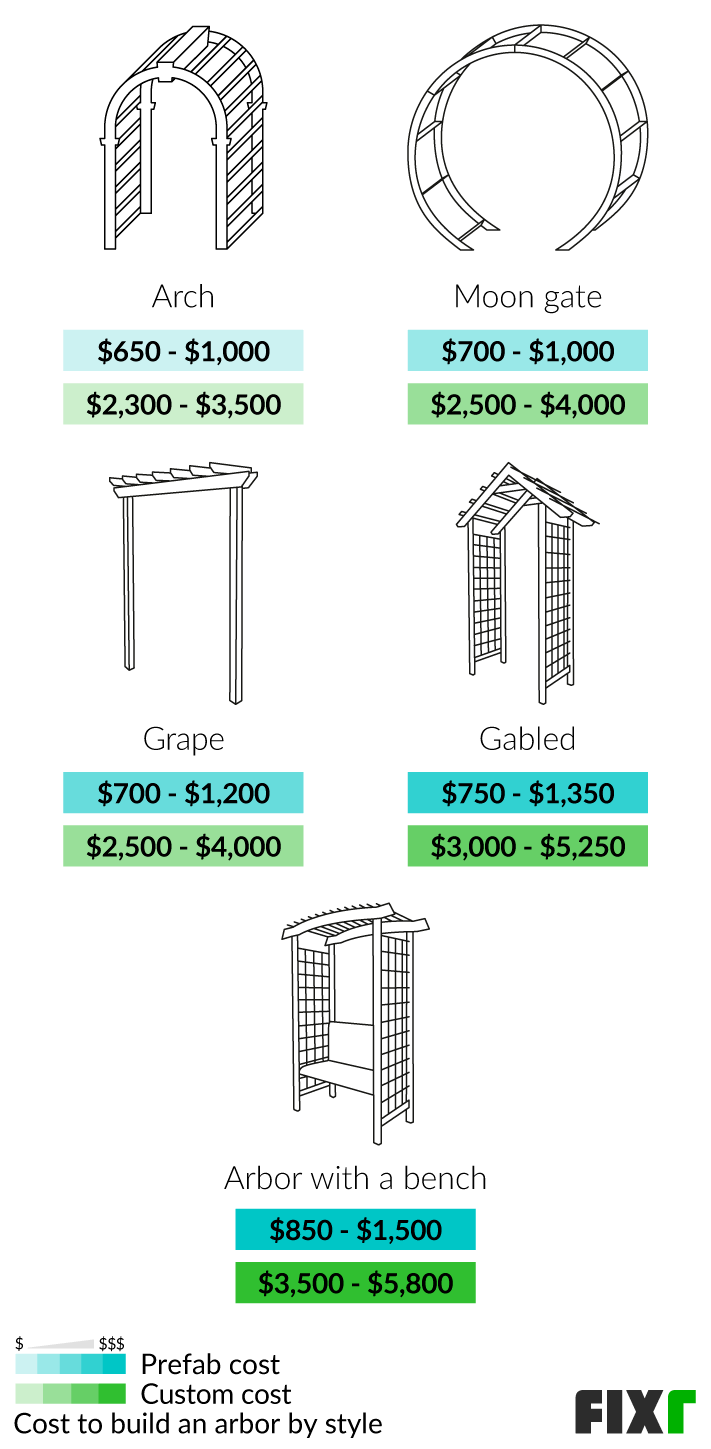

| Style | Prefab Cost (Installed) | Custom Cost (Installed) |
| Arch | $650 - $1,000 | $2,300 - $3,500 |
| Moon Gate | $700 - $1,000 | $2,500 - $4,000 |
| Grape | $700 - $1,200 | $2,500 - $4,000 |
| Gabled | $750 - $1,350 | $3,000 - $5,250 |
| Arbor With a Bench | $850 - $1,500 | $3,500 - $5,800 |
Arch Arbor
The average cost for an arched arbor is $650 to $1,000 for prefab or $2,300 to $3,500 for custom with materials and installation. The arch arbor is one of the most popular types. This style has straight walls and an arched top. This arbor may be made of any material, comes in several widths, and can be decorative or plain. This style is commonly used for weddings and is covered in vines, shells, branches, twigs, flowers, or fabric.
Moon Gate Arbor
The average cost for a moon gate arbor is $700 to $1,000 for a prefab model or $2,500 to $4,000 for custom models, including materials and installation. The moon gate is a wide arbor that looks like a half or three-quarter moon. All sides are curved. This arbor is usually made of metal but can come in other materials. The moon shape adds a decorative appeal and is commonly used for wedding ceremonies.
Grape Arbor
The average cost for a grape arbor is $700 to $1,200 when prefab or $2,500 to $4,000 for custom with materials and installation. A grape-style arbor is similar to a small-sized pergola. It has a flat top, suited to holding heavy vines with fruit, such as grapes. Whether you grow grapes for consumption or appearance, a grape arbor enhances any garden space.
Gabled Arbor
The average cost for a gabled arbor is $750 to $1,350 for prefabricated and $3,000 to $5,250 for custom, including materials and installation. A gabled arbor is defined by its pitched-style roof extending past the sides into gables. This arbor style is more decorative than the classic arch. This arbor is commonly made of wood but comes in other materials. You often see them at the beginning of a garden because they add charm.
Arbor With a Bench
The average cost for a garden arbor with a bench is $850 to $1,500 when prefabricated and $3,500 to $5,800 when custom, including materials and installation. A benched arbor does not work like a passthrough, so it usually has three sides and a top. The bench is installed along the back. This arbor adds a classic style to any garden or outdoor space and provides an extra seating area or more space for your plants.
Labor Cost to Install an Arbor
Arbor installation costs vary based on many factors, including the material, location, and if you choose a prefabricated or custom arbor. In many cases, a landscaping company provides specialists in setting up arbors. For those installing custom arbors, a carpenter must design and create the arbor. A landscaper installs the arbor once it is ready. The arbor is constructed as a custom build or through a prefabricated option. Holes are dug, and concrete or stakes secure the arbor. Installation of a prefab arbor might take only a few hours, while a custom project could take days or weeks.
Labor costs vary based on if you choose a prefabricated or custom arbor. The material also influences the labor costs. An average prefabricated arbor can be installed for around $300 to $500 for a total of $800 to $1,500 with materials. Custom models have a labor cost that ranges from $1,800 to $4,500 for a total cost of $2,550 to $5,800 with materials.

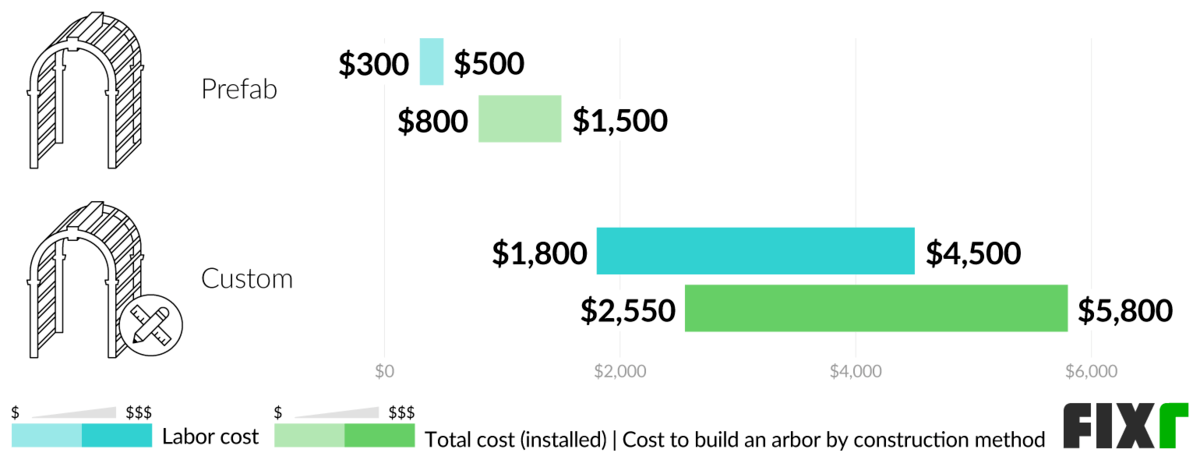
| Type | Labor Costs | Total Costs |
| Prefabricated | $300 - $500 | $800 - $1,500 |
| Custom | $1,800 - $4,500 | $2,550 - $5,800 |
Arbor Costs by Feature
Arbors can be customized for various styles and shapes. They can be built into a fence, feature a gate, or both. These extra features secure the arbor to its surroundings and increase its aesthetic appeal. Additional features increase the project cost. The chart below illustrates these features with their respective costs when using a prefabricated arbor.


| Feature | Cost (Installed) |
| Fence | $700 - $1,300 |
| Gate | $850 - $1,500 |
| Gate and Fence | $1,200 - $2,000 |
Arbor Replacement Price
In some cases, a homeowner may want to replace their arbor. This could be based on a desire for a new look or size. You can replace a specific area of the arbor if it is damaged to save money rather than doing a full replacement. For example, decorative parts can often be replaced for much less than installing a new arbor. Expect to pay around $100 to $250 if the frame or other parts need replacement. A full replacement costs about the same as your original arbor for $2,500 to $4,500. There may be an additional $100 to $250 to remove the original arbor.
Arbor With a Fence
Expect to pay between $700 and $1,300 for an arbor with a fence, not including installation fees. A fence can act as a wall helping tie the arbor to its surroundings. It directs foot traffic to an opening. A fence provides you with privacy. Also, a fence is a great complementary pairing to the arbor to serve as more support for vines or plants.
Arbor With a Gate
Expect to pay between $850 and $1,500 for an arbor with a gate, not including installation fees. Adding a gate can be the perfect finishing touch to your entryway. A gate adds an aesthetic appeal to your structure and is a good privacy piece. It separates the garden or a specific spot in your yard from the remainder and draws visitors. The structure can be finished to match your house style and color. Blend styles for a unique look and added twist. Ensure your gate is installed high enough to avoid obstructions.
Arbor With a Gate and Fence
Expect to pay between $1,200 and $2,000 for an arbor with a gate and fence, not including installation fees. Adding an arbor with a gate and fence is an excellent combination. A gate adds privacy, while a fence directs people to the gate’s entryway. Many styles of this combination bring attention to and define a spot in the yard.
Pros and Cons
You may be torn between an arbor, pergola, or trellis when considering adding an architectural feature. There are several benefits when it comes to the arbor, but nothing is perfect. For example, the arbor is less expensive to install than a gazebo but may be more expensive than a trellis or pergola. Arbors are easier to install than larger and more intricate items for the yard and garden. Arbors can fit into small spaces easily and provide a relaxation space to make your yard look nicer. They can decorate a path and have many materials.
On the other hand, arbors are small compared to gazebos. They are not as useful for more than one to two people. The small size makes them better as a private space for one or a decorative piece. The functionality might not be what everyone is looking for. In addition, arbors are less supportive of certain plants than trellises and other items if you want a garden look.

Arbor vs Pergola Cost
Pergolas and arbors both accent landscaping. They offer shade and a spot for vine growth. However, arbors are vertical and often sit in walkways, while pergolas are larger and may be installed on patios, pools, and decks. Some pergolas attach to a home while others are freestanding. Arbors can have overhead arches, gates, and benches, while pergolas are more open. The main distinguishing difference between a pergola and an arbor is that an arbor is an entryway into a different part of your yard or garden. A pergola is an outdoor living space. The average cost for a pergola ranges from $1,900 to $6,500, while an arbor can be installed for $2,500 to $4,500.

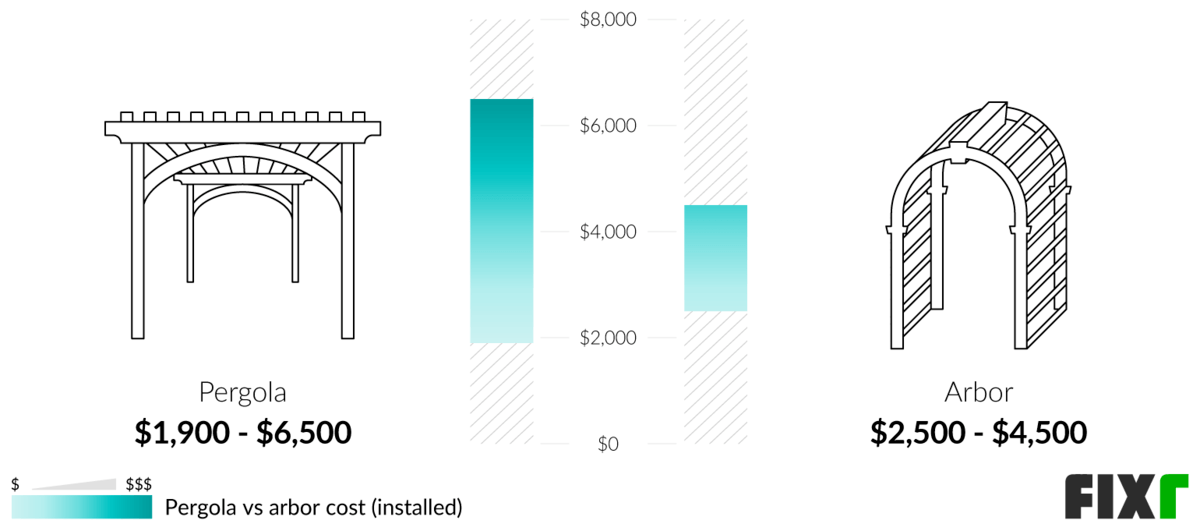
| Type | Cost (Installed) |
| Pergola | $1,900 - $6,500 |
| Arbor | $2,500 - $4,500 |
Arbor vs Gazebo Cost
Gazebos are standalone yard items with more structure than an arbor. They often come in round shapes and have a pitched roof. Gazebos may or may not have walls. They are supported by columns and may have railings and benches for seating. Compared to arbors, gazebos are larger and may be used as a centerpiece in a garden or for outdoor performances like bands. Arbors are smaller and can be used in spaces that might be more limited. Arbors create privacy, direct flow, support plants, and separate landscapes. While arbors average $2,500 to $4,500, a gazebo can be much more expensive at $7,500 to $10,000.
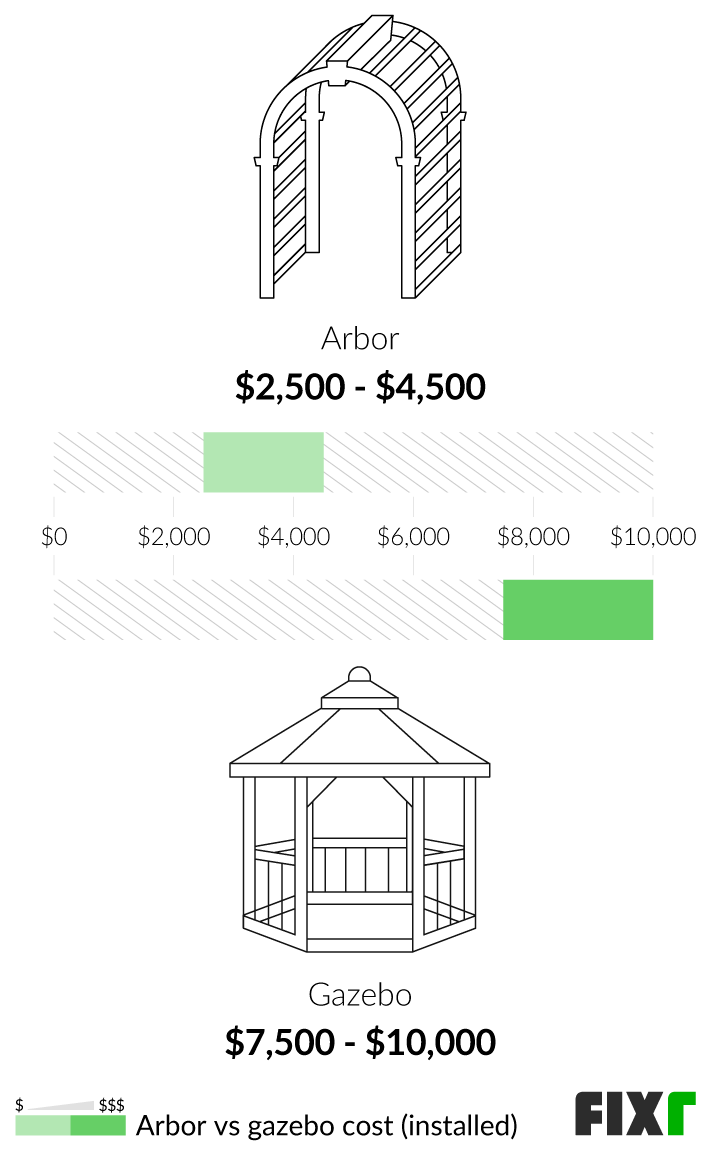
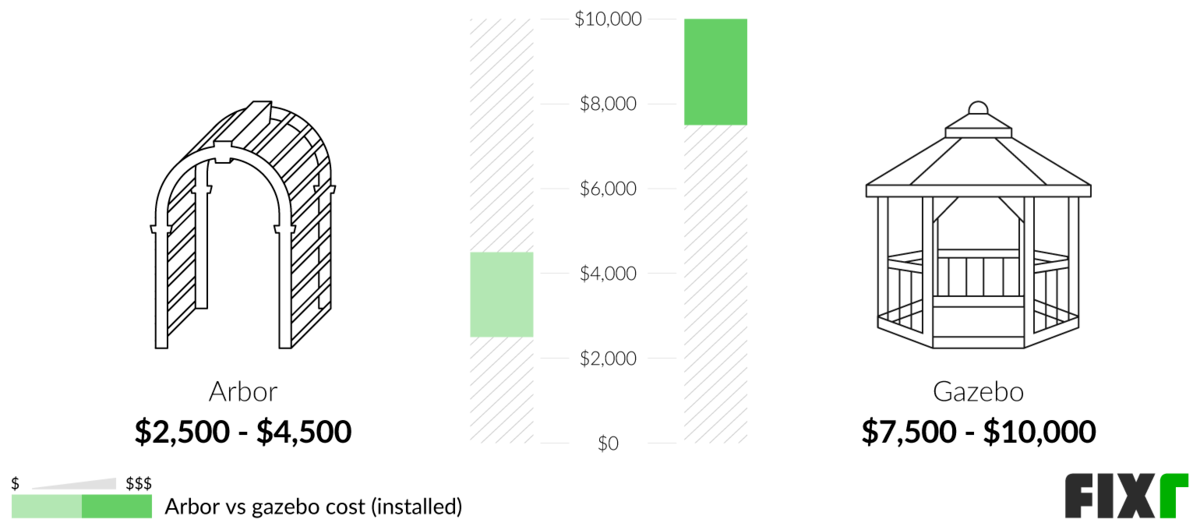
| Type | Cost (Installed) |
| Arbor | $2,500 - $4,500 |
| Gazebo | $7,500 - $10,000 |
Arbor vs Trellis Cost
An arbor is an open structure and tends to be smaller than a trellis. It may have an arched top and includes interwoven lattice pieces. An arbor often distinguishes parts of a yard or garden. A trellis is a woven yard item with lattice or an open framework. It may be used to divide areas or create shade. The biggest difference between an arbor and a trellis is that a trellis is specifically made to grow plants like ivy and flowers. An arbor is more commonly used as a visual addition to a yard or garden that adds an aesthetic flair to the property. A trellis averages $650 to $950, while an arbor is more expensive at $2,500 to $4,500.

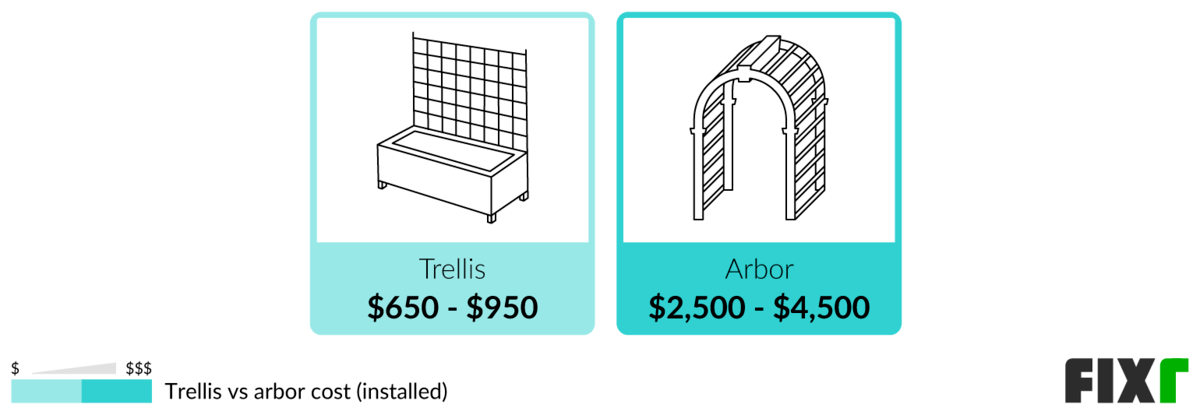
| Type | Cost (Installed) |
| Trellis | $650 - $950 |
| Arbor | $2,500 - $4,500 |
Enhancement and Improvement Costs
Arbor Plants
Arbors are designed to allow plant growth. These plants range in price from $10 to $50. The best plants are directly influenced by your structure size, shape, and material. Metal arbors can handle more aggressive plants, such as wisteria, while a grape arbor can handle hefty plants, including grapes, passionflower, and trumpet vines. More common arbor plants include honeysuckle, jasmine, roses, and grapevines.
Paint an Arbor
The average cost to paint an arbor is $5 to $7 per sq.ft. When painting an arbor, many homeowners choose a less-expensive wood because its appearance is covered. Staining an arbor is also an option for about the same price. Wood with a clear grain like cedar is a common choice for this. If primer is required, the cost per square foot rises to about $10 to $14. Arbors with other materials may not need painting. For example, a vinyl arbor needs no painting, while metal arbors can be powder coated.
Secure Garden Arbor
The price for a professional to secure the arbor ranges from $100 to $250. Securing a garden arbor ensures it does not fall and experience damage, especially in bad weather or extreme winds. To properly secure an arbor, concrete needs to be placed in the post holes before installing the arbor. This is not overly challenging, but there may be problems with the hole spreading or drying before installing the arbor. Concrete forms can help with this problem.
Additional Considerations and Costs
- Climate and season. Metal and vinyl arbors can be better in climates that experience high winds. They can be secure structures if you sink them into concrete for the footings. The season when you purchase the arbor also affects pricing. There are often excellent discounts available if you research prices in the late autumn or early winter.
- DIY. Installing an arbor in your yard can be a DIY project. There are arbor kits available for purchase, which provide you with step-by-step instructions for assembling the structure. Building an arbor can be easy using these kits and can be far less expensive than one purchased from a commercial source or custom-built to your specifications.
- Home value. Adding an arbor increases your home value if it is in good shape. Buyers are always interested in homes with special yard, patio, and garden features.
- Design. There are dozens of designs to select from. Homeowners can choose something simple like plain wood or highly intricate with artistic designs in the wood or other materials.
- Permits. In some locations, a permit may be needed to install an arbor. In others, there is no requirement. Reach out to your municipality to learn if you need a permit.
- Repair. With proper maintenance, an arbor made of high-quality material can last for decades. However, damage can occur that may require repairs. The best option is to reach out to the person who installed the arbor to have it repaired. The most common repair needed for an arbor is restaining or repainting, about $200 to $500 for a 10’ x 10’ structure.
- Birdhouse hangers. Arbors can have birdhouse hangers added to invite wildlife, typically costing around $20 to $50 per hanger. Adding hangers can make an arbor more functional by providing a spot for birds to rest, eat, or live. You can add birdhouses along the top or side to convince birds to perch in the area. Use the houses as a point of interest or tuck them out of the way, depending on your preference.
- Wedding arbor. Many people use an arbor at their wedding. It can be the background for the ceremony and add visual interest to the reception. In some cases, it can be used by guests for taking photos. A simple flower arch might cost $75 to $150 if you rent one for the ceremony. Prices are similar to traditional arbors if it is made and installed for further use after the wedding is complete.
FAQs
- How much does an arbor cost?
The average cost for installing an arbor is between $2,500 and $4,500, with most people paying around $3,500 for a custom-built arbor with a grape style and bench.
- What can I plant to grow on an arbor?
The best plants for an arbor are those that weave around. Rambling rose, jasmine, clematis, and honeysuckle are some of the best choices because they only require coaxing on where you want them to go.
- How tall should a garden arbor be?
A garden arbor should be tall and wide enough to walk through. It should be at least 6’ high and 3’ wide.
- Where should a garden arch be placed?
A garden arch can be placed where the ground is level and clear of rocks or weeds. Placing it against a wall or fence provides extra support, but soft or medium grassland provides the best anchoring wherever you choose.
- How do I secure my arbor?
An arbor can be secured to a hard ground surface using brackets and stakes attached to each leg for soft surfaces. Holes are dug for a more secure hold, and concrete is poured to hold the arbor into the ground.
- What kind of wood should I use to build an arbor?
The choice of wood varies based on your needs and budget. For example, cedar, bamboo, and pine are less expensive and easier to access than oak, redwood, and teak arbors. Some woods are more aesthetically pleasing to homeowners than others, but that comes down to personal taste.
